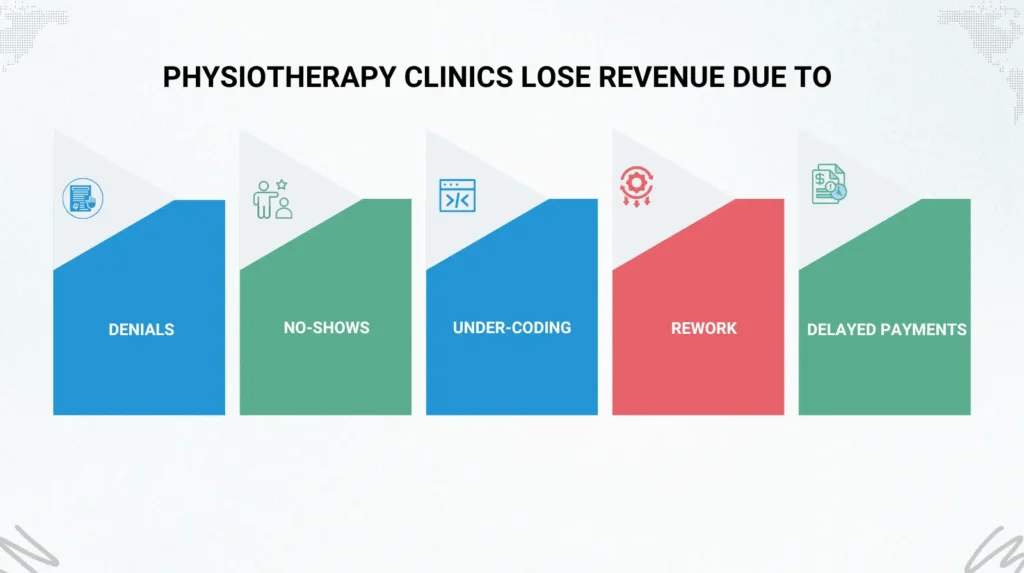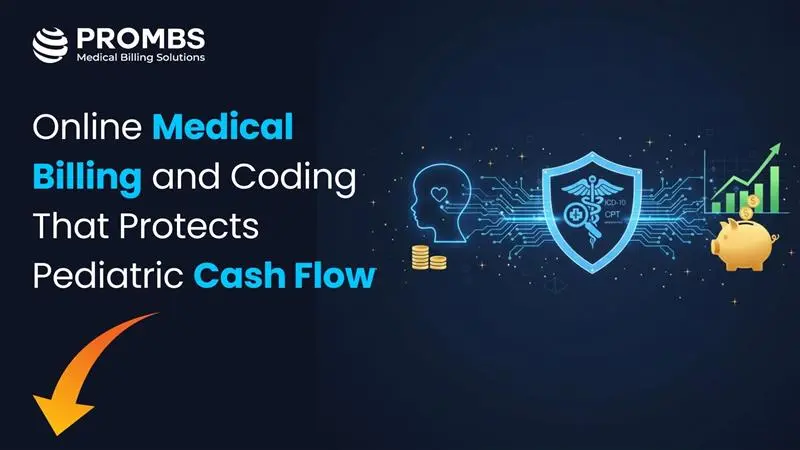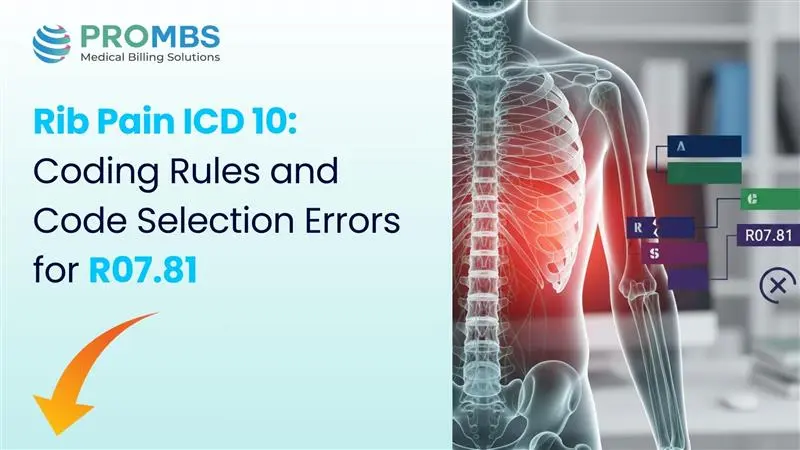Physical therapy revenue recovery has never been more important. Clinics work hard, but many lose 10–20% of their potential income each month. The reasons are often small. A missed modifier. A late note. A claim that never went out. But together, they add up to real money lost. Recovery isn’t just about chasing payments. It’s about stopping leaks before they start. And that’s where data automation makes a difference. It connects billing, compliance, and reporting systems so you can see every dollar, every visit, every claim in real time.
Want to know what contributes the most to losing annual revenue to preventable denials? The Healthcare Financial Management Association (HFMA) reported that healthcare providers lose about 7% of annual revenue to preventable denials. That’s not just a statistic. It’s a warning sign. The number may not look so big but in long term it will slowly eat into your revenue and affect your cash flow.
The Revenue Challenge in Physical Therapy Clinics
Let’s be honest, manual billing slows everything down. Therapists finish their notes late. Coders guess at modifiers. Someone forgets to recheck a denial. Before you know it, thousands of dollars are stuck in limbo. According to CMS (Centers for Medicare & Medicaid Services), inaccurate or incomplete claims are among the top reasons for payment delays in outpatient rehab. Many clinics report denial rates above 10–15% and Accounts Receivable (A/R) days stretching past 45.
That’s time and money you’ll never get back, and most clinics don’t even realize how much they’re losing. They get used to slow payments and constant denials, calling it part of the job. Weeks go by. Claims sit untouched. Staff work late trying to fix errors that should have been caught in the first place. It feels normal after a while, but it’s not. That constant cycle doesn’t have to continue. Automation can stop those leaks before they start and finally put your revenue back on track.

What Data Automation Really Means
When people hear the word “automation,” they often think of machines replacing humans. That’s not what it means here. In physical therapy, data automation is simply a smarter way to manage the routine parts of your billing and revenue cycle. It checks patient eligibility before a visit. It flags errors before a claim leaves your system. It sends reminders when a payer hasn’t responded. It also gives you dashboards that make your revenue visible instead of hidden in spreadsheets.
Think of it as an assistant who never forgets a step and never gets tired. It keeps your clinic compliant with CMS and AMA (American Medical Association) standards while freeing your staff to focus on patients, not paperwork.
How Automation Helps You Recover More Revenue
Fewer Claim Denials
Claim scrubbing works quietly but makes a big difference. It scans every claim and spots missing data, wrong codes, or bad modifiers before they cause trouble. Most clinics don’t realize how many small errors slip through until they start using it. A clean claim means faster payments and fewer back-and-forth delays with payers. The HFMA even calls this one of the easiest and most effective ways to cut down on denials before they ever happen. It’s a small step that saves a lot of time and money in the long run.
Faster Payments
Finding Hidden Revenue
Analytics dashboards show what’s really going on. They catch what your eyes might miss. Maybe it’s unbilled visits. Maybe it’s a CPT code that never made it through. Those small gaps add up fast. The AMA reminds clinics that accurate charge capture is the foundation of fair reimbursement. Automation makes that part easy. It connects the dots, closes the gaps, and keeps every claim clean before it hits the payer’s desk.
Fewer No-Shows
Compliance and Audit Readiness
How to Get Started with Automation
Before investing in any new system, take a good, honest look at how your current revenue cycle works. Follow each step from patient visit to final payment. You’ll start to see where things stall. Maybe it’s delays in documentation. Maybe the same coding mistakes keep showing up. Those repeated slowdowns are your biggest opportunities for improvement. Finding them now makes automation far more effective later.
Here’s a clear plan to follow:
1-Map your process. Write down how claims move from visit to payment.
2-Choose tools that connect. Your billing, EHR, and analytics should sync automatically.
3-Clean your data. Automation works best with accurate, consistent information.
4-Train your staff. Everyone should know how alerts, triggers, and reports work.
5-Track your progress. Watch key metrics month after month.
Key Performance Indicators to Watch:
- Denial Rate: The percentage of claims that get rejected.
- Days in Accounts Receivable (A/R): How long it takes to get paid.
- Cost per Claim: The expense of submitting and processing each claim.
- Clean Claim Rate: The share of claims approved on first submission.
- Reimbursement per Visit: The average payment you collect per patient session.
- No-Show Rate: The percentage of missed or canceled visits.
| KPI | Before Automation | After Automation | Improvement |
|---|---|---|---|
| Denial Rate | 14% | 6% | ↓ 57% |
| Days in Accounts Receivable (A/R) | 47 | 24 | ↓ 49% |
| Clean Claim Rate | 89% | 97% | +9% |
| Reimbursement per Visit | $72 | $83 | +15% |
The HFMA reports that clinics using automation can cut denial-related costs by as much as 60 percent. That’s not a small improvement; it’s a real financial shift. Think about what that means for your clinic. Fewer denials, less rework, and more time to focus on patient care instead of paperwork. For most physical therapy practices, that kind of savings changes everything. It proves that smarter systems don’t just make billing easier, they make your business stronger.
Case Example: How One Clinic Turned Data into Dollars
A five-provider PT clinic was struggling. Denials piled up. Payments took weeks. Staff were overwhelmed. They switched to an automated billing and analytics platform. Within months, everything changed.
- Denials dropped from 12% to 5%
- Payments came in 40% faster
- Monthly collections rose by 18%
The clinic’s owner could finally see where the money was getting stuck. For the first time, the numbers made sense. Patterns appeared that had been invisible before. Automation didn’t just fix billing; it handed the team real control over their finances. They could track payments, spot trends, and make changes before problems grew. The AMA points out that clinics using real-time data make smarter, faster financial decisions, and this clinic proved it.
Common Hurdles and How to Overcome Them
Change can feel uncomfortable. Some clinics hesitate because of cost or fear of complexity. Others worry about staff resistance. Here’s the truth. Automation pays for itself when used right. Start small. Test one workflow. Show your team how much time it saves. Once they see the results, they’ll want it everywhere.
Choose HIPAA (Health Insurance Portability and Accountability Act)-compliant systems so your patient data stays secure. Track ROI with metrics like reduced denials and shorter A/R days. CMS data shows that clinics using automation meet billing accuracy standards more consistently than those that rely on manual systems. That’s proof it works.
What’s Next for PT Revenue Automation
more intuitive than ever. The tools being built today don’t just react to mistakes, they stop them before they happen. That’s the next big leap for physical therapy clinics. Smarter systems will predict errors, correct them instantly, and keep your billing clean from the start. It’s progress that turns guesswork into confidence and keeps your revenue flowing smoothly.
Expect:
- Predictive analytics that warn you about high-risk claims.
- AI-assisted charge validation based on AMA CPT updates.
- Automated payer policy mapping that keeps your billing rules current.
- Telehealth billing integration as virtual therapy expands.
- Real-time benchmarking dashboards that compare multiple locations.
These new tools are designed to make PT billing simpler and smoother for everyone. They cut out the confusion that often slows claims down. Payments move faster, and accuracy improves with every step. Clinics no longer have to second-guess codes or worry about missing details. Each process stays aligned with CMS guidelines and payer requirements. The result is a system that works smarter, saves time, and keeps your billing fully compliant.
Let Pro-MBS Help You Recover Your Lost Revenue
At the end of the day, physical therapy revenue recovery is all about control. You can’t recover what you can’t see, and that’s where data automation changes everything. It gives you a clear picture of your revenue, from the first patient visit to the final payment. Claims stay clean, reimbursements arrive faster, and compliance stays on track. Your team spends less time fixing mistakes and more time focusing on care. Over time, stress fades and cash flow becomes predictable.
That’s the kind of difference Pro-MBS helps clinics achieve every day. From revenue cycle audits to automated billing solutions, our team works with you to close gaps, reduce denials, and recover more of what you earn. We build systems that fit your workflow, not the other way around.
Start small. Track your results. Watch your numbers improve month after month. That’s how you turn automation into a steady, long-term growth strategy with Pro-MBS by your side.
FAQs
How to maximize physical therapy billing?
You can maximize physical therapy revenue recovery by automating claim scrubbing, tracking denials, and using data dashboards that reveal payment gaps. This ensures faster reimbursements, fewer A/R delays, and full CMS compliance.
Is there a future in physical therapy?
Yes, the future of physical therapy looks strong. With automation and data-driven systems improving revenue recovery, clinics can focus more on patient outcomes while maintaining financial stability and compliance.
How can technology and automation tools streamline the revenue cycle and bookkeeping processes in a medical office?
Automation enhances physical therapy revenue recovery by syncing billing, EHR, and analytics systems. It reduces manual work, prevents data errors, tracks claims in real time, and keeps bookkeeping transparent across all payers.
What are the 4 elements of the revenue cycle?
The four elements are patient registration, charge capture, claim submission, and payment posting. Each step supports therapy revenue recovery when powered by automation and clean data management.
What is automation in the revenue cycle?
Automation in the revenue cycle means using smart software to manage repetitive billing tasks. It strengthens physical therapy revenue recovery by preventing claim errors, flagging denials, and ensuring faster, cleaner reimbursements.
How to bill BFR in physical therapy?
Blood Flow Restriction (BFR) training can be billed under therapeutic exercise CPT 97110 when medically necessary. For accurate physical therapy revenue recovery, ensure proper documentation and compliance with payer-specific coding rules.
What is the PT protocol for BFR?
The PT protocol for BFR involves low-load resistance training with partial limb occlusion to improve muscle strength and recovery. Documenting time, intensity, and medical necessity helps protect physical therapy revenue recovery and reimbursement accuracy.



